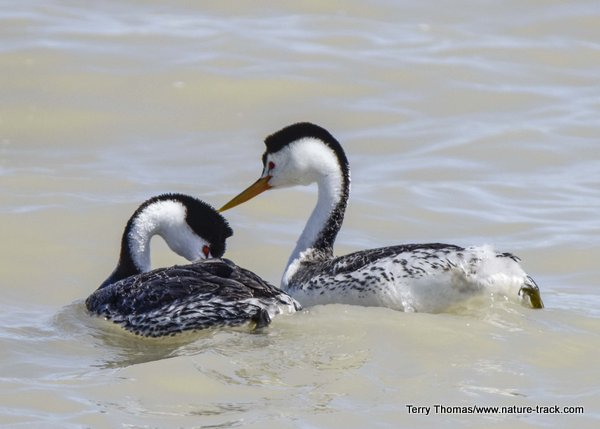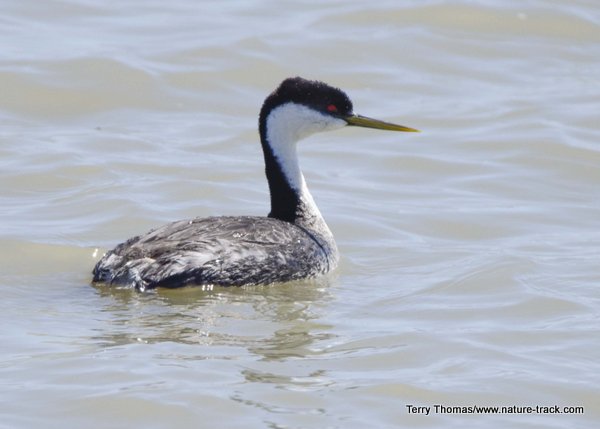Western and Clark's Grebes


These photos of a pair of Clark’s grebes and a single western grebe clearly show the eye in the white (Clark’s) and in the black (western). The difference in bill color is also visible.
This conversation happens just about every time we see a black and white bird on water: Wife: “Well, it is definitely a grebe.” Me: “Yes, but is it a western grebe or a Clark’s grebe?” Wife, excitedly: “I think it is a Clark’s grebe!” (definitely the more thrilling find for us as we usually see 95 percent western grebes). Me: “Can you tell if the eye is in the white or in the black?” Wife: “I am sure it is in the white!” Me, less enthusiastically: “Let me get out the spotting scope just to be sure.”
Once the scope is set up, we are usually disappointed to find that the suspect bird is yet another western grebe. That changed several weeks ago at Bear River National Waterfowl Refuge near Brigham City, Utah. We actually saw a large number of Clark’s grebes, and is often the case, they were pretty easy to identify, even with binoculars, so long as we had a good profile to work with.
These two species are remarkably similar looking. Both are black on the back with a broad black stripe reaching up the back of the neck and to the bill. The underside is white including the lower half of the face and neck. And they both sport incredible red eyes. The biggest difference between the two, at least in looks, is the black on the top of the head. In the western grebe, the black extends down to just under the eye. In the Clark’s grebe, the black ends above the eye so that the eye is actually in the white portion that makes up the throat and sides of the face and neck.
I got to where I could quickly identify a Clark’s grebe even without binoculars and I wondered what I was keying on. It turned out that because the black portion on top of the head of the Clark’s grebe is thinner, it has the appearance, at least to me, of being more arched and even a bit crown-like, perhaps like a mohawk haircut. This seemed pretty obvious after watching several birds closely.
I also noticed that the Clark’s grebe has a bill that is more orange than that of a western grebe (whose bill is more yellow). However, for me, that is one of those identification features that works best when the two are close by for comparison.
These two species were one species until 1985. By then, scientists and taxonomists realized that the two species rarely interbreed even if they live in close proximity. They have substantial DNA differences and make different calls as well, justifying a split into separate species.
Behaviorally, the two species are very similar. Their amazing courtship displays are virtually identical. Western grebes, however, tend to forage closer to shore and Clark’s grebes prefer deeper water. Perhaps that is why we see so many more western than Clark’s grebes—they are nearer shore. This does lead to one behavior that can be noticeable as well: the Clark’s grebe tends to use a more upward leap when diving, possibly because it forages deeper than the western grebe.
Finally, the breeding range is almost identical for both species. These truly are birds of the West. They both breed from California to the Great Plains and southwest Canada to Mexico.
I hope that now we have had an opportunity to really see the differences between the two species, it won’t be difficult to determine one from the other. Perhaps our conversations will improve too.
Help Idaho Wildlife
When we traveled across the state in October 2017, most of the vehicles we saw using the wildlife management areas did not have wildlife plates. Buying wildlife plates is a great way for non-hunters and hunters alike to support wildlife-based recreation like birding.
C'mon folks, let's help Idaho's wildlife by proudly buying and displaying a wildlife license plate on each of our vehicles!
See below for information on Idaho plates. Most states have wildlife plates so if you live outside Idaho, check with your state's wildlife department or vehicle licensing division for availability of state wildlife plates where you live.
And tell them that you heard about it from Nature-track.com!

Wildlife License Plates
Great news! as of 2024, there are three NEW designs for license plates. They still are bluebird, cutthroat trout and elk, but they are beautiful.
Idaho Wildlife license plates provide essential funding that benefits the great diversity of native plants and wildlife that are not hunted, fished or trapped—over 10,000 species or 98% of Idaho’s species diversity. Game species that share the same habitats (such as elk, deer, antelope, sage-grouse, salmon, trout) also benefit from these specialty plates.
No state tax dollars are provided for wildlife diversity, conservation education and recreation programs. Neither are any revenues from the sale of hunting or fishing licenses spent on nongame species. Instead, these species depend on direct donations, federal grants, fundraising initiatives—and the Idaho Wildlife license plates.
Both my vehicles have Bluebird Plates. I prefer the bluebird because the nongame program gets 70 percent of the money from bluebird plates, but only 60 percent of the money from elk and trout plates - 10 percent of the money from elk plates supports wildlife disease monitoring and testing programs (to benefit the livestock industry) and 10 percent from cutthroat plates supports non-motorized boat access.
Incidentally, in 2014, the Idaho Legislature denied the Department of Fish and Game the ability to add new plates or even to change the name of the elk and cutthroat plates (very specific) to wildlife and fish plates, a move that would have allowed for changing images occasionally and generating more revenue. It would seem that they believe that we Idahoans don't want a well funded wildlife program.
I think it is time we let the Legislature know that Idahoan support wildlife funding and that we would like to see these generic plates come to fruition.

"WOW. What a phenomenal piece you wrote. You are amazing." Jennifer Jackson
That is embarrassing, but actually a fairly typical response to my nature essays. Since The Best of Nature is created from the very best of 16 years of these nature essays published weekly in the Idaho Falls Post Register (online readership 70,000), it is a fine read. It covers a wide variety of topics including humorous glimpses of nature, philosophy, natural history, and conservation. Readers praise the style, breadth of subject matter and my ability to communicate complex and emotional topics in a relaxed and understandable manner.
Everyone can find something to love in this book. From teenagers to octogenarians, from the coffee shop to the school room, these nature essays are widely read and enjoyed.
Some of the essays here are my personal favorites, others seemed to strike a chord with readers. Most have an important message or lesson that will resonate with you. They are written with a goal to simultaneously entertain and educate about the wonderful workings of nature. Some will make you laugh out loud and others will bring a tear to the eye and warm your heart.
Readers Write:
"You hit a home run with your article on, Big Questions in Nature. It should be required reading for everyone who has lost touch with nature...great job!" Joe Chapman
"We enjoyed your column, Bloom Where Planted. Some of the best writing yet. The Post Register is fortunate to have your weekly columns." Lou Griffin.
To read more and to order a copy, click here or get the Kindle version
Copies are also available at:
Post Register
Island Park Builders Supply (upstairs)
Barnes and Noble in Idaho Falls
Harriman State Park, Island Park
Museum of Idaho
Valley Books, Jackson Wyoming
Avocet Corner Bookstore, Bear River National Wildlife Refuge, Brigham City, Utah
Craters of the Moon National Monument Bookstore, Arco, Idaho